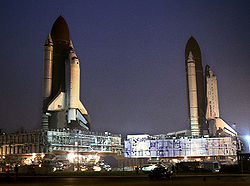
STS-38
Encyclopedia
Mission parameters
- MassMassMass can be defined as a quantitive measure of the resistance an object has to change in its velocity.In physics, mass commonly refers to any of the following three properties of matter, which have been shown experimentally to be equivalent:...
:- Payload: Magnum ELINT satellite ~ 3000 kilograms (6,613.9 lb)
- Booster: IUS upper stage ~ 18000 kilograms (39,683.2 lb)
- Total: ~ 21000 kilograms (46,297.1 lb)
- PerigeePerigeePerigee is the point at which an object makes its closest approach to the Earth.. Often the term is used in a broader sense to define the point in an orbit where the orbiting body is closest to the body it orbits. The opposite is the apogee, the farthest or highest point.The Greek prefix "peri"...
: 78 kilometres (48.5 mi) - Apogee: 226 kilometres (140.4 mi)
- InclinationInclinationInclination in general is the angle between a reference plane and another plane or axis of direction.-Orbits:The inclination is one of the six orbital parameters describing the shape and orientation of a celestial orbit...
: 28.5° - PeriodOrbital periodThe orbital period is the time taken for a given object to make one complete orbit about another object.When mentioned without further qualification in astronomy this refers to the sidereal period of an astronomical object, which is calculated with respect to the stars.There are several kinds of...
: 87.5 min
Preparations and Launch



Space Shuttle Columbia
Space Shuttle Columbia was the first spaceworthy Space Shuttle in NASA's orbital fleet. First launched on the STS-1 mission, the first of the Space Shuttle program, it completed 27 missions before being destroyed during re-entry on February 1, 2003 near the end of its 28th, STS-107. All seven crew...
during STS-35
STS-35
-Crew notes:Prior to the Challenger disaster, this mission was slated to launch in March 1986 as STS-61-E. Jon McBride was originally assigned to command this mission, which would have been his second spaceflight. He chose to retire from NASA in May 1989 and was replaced as mission commander by...
countdown prompted three precautionary tanking tests on Atlantis at pad 29 June, 13 July and 25 July 1990. Tests confirmed the hydrogen fuel leak on the external tank side of the external tank/orbiter 432 millimetres (17 in) quick disconnect umbilical.
This could not be repaired at the pad and Atlantis rolled back to the VAB on 9 August 1990, was demated, then transferred to the Orbiter Processing Facility
Orbiter Processing Facility
An Orbiter Processing Facility was one of three hangars where U.S. space shuttle orbiters underwent maintenance between flights. All three such facilities, OPF-1, OPF-2 and OPF-3, were located at NASA's Kennedy Space Center in Florida at Launch Complex 39.They were located west of the Vehicle...
(OPF). During rollback, the vehicle remained parked outside the VAB for about a day while the Columbia/STS-35 stack was transferred to the pad for launch. While outside, Atlantis suffered minor hail damage to its tiles during a thunderstorm. After repairs were made in the OPF, Atlantis was transferred to the VAB for mating on 2 October 1990. During hoisting operations, the platform beam that should have been removed from aft compartment fell and caused minor damage which was repaired. The vehicle rolled out to Pad A on 12 October 1990. The fourth mini-tanking test was performed on 24 October 1990, with no excessive hydrogen or oxygen leakage detected. During the Flight Readiness Review, the launch date was set for 9 November 1990. Launch was reset for 15 November 1990 due to payload problems. Liftoff occurred during classified launch window lying within a launch period extending from 18:30 to 22:30 EST, 15 November 1990.
Classified Payload
During STS-38, Atlantis deployed USA-67. According to Aviation Week, this was a secret MagnumMagnum (satellite)
Magnum is the code name for a class of SIGINT spy satellites reportedly operated by the National Reconnaissance Office for the United States Central Intelligence Agency...
ELINT (ELectronic INTtelligence) gathering satellite headed for geosynchronous orbit
Geosynchronous orbit
A geosynchronous orbit is an orbit around the Earth with an orbital period that matches the Earth's sidereal rotation period...
like those launched by STS-51-C
STS-51-C
STS-51-C was the 15th flight of NASA's Space Shuttle program, and the third flight of Space Shuttle Discovery. It was also the first shuttle mission to deploy a dedicated United States Department of Defense payload, and as such many mission details remain classified...
and STS-33
STS-33
-Crew notes:S. David Griggs, the originally scheduled pilot for STS-33, died in a plane crash in June 1989, five months prior to the scheduled launch, and was replaced by John E...
, launched to monitor the events during the first Gulf War
Gulf War
The Persian Gulf War , commonly referred to as simply the Gulf War, was a war waged by a U.N.-authorized coalition force from 34 nations led by the United States, against Iraq in response to Iraq's invasion and annexation of Kuwait.The war is also known under other names, such as the First Gulf...
in 1990. Also according to Aviation Week, the shuttle initially entered a 204 kilometres (126.8 mi) x 519 kilometres (322.5 mi) orbit at an inclination of 28.45° to the equator. It then executed three OMS (orbital maneuvering system) burns, the last on orbit #4. The first of these circularized the orbit at 519 kilometres (322.5 mi). Later observers have speculated that USA-67 was instead a secret SDS-2
Satellite Data System
The Satellite Data System is a system of United States military communications satellites. At least three generations have been used: SDS-1 from 1976 to 1987; SDS-2 from 1989 to 1996; SDS-3 from 1998 to the present...
military communications satellite, like those deployed on STS-28
STS-28
STS-28 was the 30th NASA Space Shuttle mission, the fourth shuttle mission dedicated to United States Department of Defense purposes, and the eighth flight of Space Shuttle Columbia. The mission launched on 8 August 1989, lasted just over 5 days, and traveled 2.1 million miles during 81 orbits...
and STS-53
STS-53
-Mission parameters:*Mass:**Orbiter landing with payload: **Payload: *Perigee: *Apogee: *Inclination: 57.0°*Period: 92.0 min-Mission highlights:...
. A publicly released image of the vertical stabilizer and upper aft bulkhead, similar to the one released from STS-53, confirms that the ASE (Airborne Support Equipment) for the IUS was absent from this flight. The satellite was deployed on the 7th orbit and then ignited its rocket motor at the ascending node of the 8th orbit, to place it in a geo-synchronous transfer orbit.
Rumours that now appear to have been substantiated by the identification of an "unknown" geostationary satellite by amateur observers insist that a second secret payload was deployed: Prowler. Prowler is reportedly a stealth satellite intended to covertly inspect other nation's geostationary satellites . Landing occurred 20 November 1990, 16:42:42 EST, Runway 33, Kennedy Space Center
Kennedy Space Center
The John F. Kennedy Space Center is the NASA installation that has been the launch site for every United States human space flight since 1968. Although such flights are currently on hiatus, KSC continues to manage and operate unmanned rocket launch facilities for America's civilian space program...
, FL. Rollout distance: 2753 metres (9,032.2 ft). Rollout time: 57 seconds. Mission extended one day due to unacceptable crosswinds at original planned landing site, Edwards. Continued adverse conditions led to decision to shift landing to KSC. First KSC landing for Atlantis, first end-of-mission landing at KSC since April 1985. Landing Weight: 191,091 lb (86.667 Mg).
See also
- Space scienceSpace scienceThe term space science may mean:* The study of issues specifically related to space travel and space exploration, including space medicine.* Science performed in outer space ....
- Space shuttleSpace ShuttleThe Space Shuttle was a manned orbital rocket and spacecraft system operated by NASA on 135 missions from 1981 to 2011. The system combined rocket launch, orbital spacecraft, and re-entry spaceplane with modular add-ons...
- List of space shuttle missions
- List of human spaceflights chronologically
External links
----

